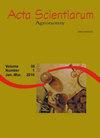不同种植密度下无刺仙人掌的产草量及结构响应
IF 1.2
4区 农林科学
Q3 AGRONOMY
引用次数: 3
摘要
目的是评价无刺仙人掌Orelha de Elefante Mexicana (Orelha de Elefante Mexicana) (Opuntia stricta (Haw.))的饲料产量和结构响应。不同的种植密度。试验设计为随机区组,5个处理,4个重复,2个生产周期,每个周期12个月。评估密度为2万;25000;33333;50000;10万株ha-1。种植密度的增加导致植物株高、株宽、株质量以及初级、次级、三级枝和总枝的数量呈线性减少。同时使枝部面积指数、干绿产量、水分利用效率和牧草积累率呈线性增加。种植密度的增加促进了枝部厚度和干物质含量的二次效应。枝层厚度随着种植密度的增加而减小,最高可达47500株hm -1;干物质含量在种植密度为61428株hm -1时呈上升趋势,此后呈下降趋势。无刺仙人掌“Orelha de Elefante Mexicana”种植密度的增加引起了结构响应和饲料产量的变化。采用较大的种植密度可提高牧草产量。本文章由计算机程序翻译,如有差异,请以英文原文为准。
Forage yield and structural responses of spineless cactus ‘Orelha de Elefante Mexicana’ at different planting densities
The objective was to evaluate the forage yield and structural responses of spineless cactus ‘Orelha de Elefante Mexicana’ (OEM) (Opuntia stricta (Haw.) Haw) at different planting densities. The experimental design was a randomized block with five treatments and four replicates, during two production cycles of 12 months each. The evaluated densities were 20,000; 25,000; 33,333; 50,000; and 100,000 plants ha-1. The increase in planting density caused a linear reduction in plant height, width, and mass, as well as in number of primary, secondary, tertiary, and overall cladodes. It also caused a linear increase in cladode area index, dry and green yield, water use efficiency, and forage accumulation rate. The increase in planting density promoted a quadratic effect on cladode thickness and dry matter content. Cladode thickness decreased with planting densities up to 47,500 plants ha-1 and increased from this point onwards. As for dry matter content, there was an increase up to the planting density of 61,428 plants ha-1 and a decrease from this point onwards. The increase in planting density of spineless cactus ‘Orelha de Elefante Mexicana’ caused changes in structural responses and in forage yield. The use of greater planting densities increased forage yield.
求助全文
通过发布文献求助,成功后即可免费获取论文全文。
去求助
来源期刊

Acta Scientiarum. Agronomy.
Agricultural and Biological Sciences-Agronomy and Crop Science
CiteScore
2.40
自引率
0.00%
发文量
45
审稿时长
>12 weeks
期刊介绍:
The journal publishes original articles in all areas of Agronomy, including soil sciences, agricultural entomology, soil fertility and manuring, soil physics, physiology of cultivated plants, phytopathology, phyto-health, phytotechny, genesis, morphology and soil classification, management and conservation of soil, integrated management of plant pests, vegetal improvement, agricultural microbiology, agricultural parasitology, production and processing of seeds.
 求助内容:
求助内容: 应助结果提醒方式:
应助结果提醒方式:


